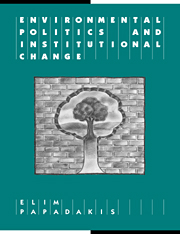Book contents
- Frontmatter
- Contents
- List of Tables and Figures
- Preface and acknowledgements
- Abbreviations
- Part I Introduction
- Part II Political Institutions, Innovation and Social Change
- Part III Political Organisations and Adaptation
- Part IV The Media, Agenda Setting and Public Opinion
- 13 The articulation of environmental issues by the media
- 14 Media stereotypes and adaptation
- 15 Public opinion and survey research
- 16 Mass opinion on environmental issues
- Part V Conclusion
- Appendix: Codes used in tables 9.1 to 12.1
- Notes
- References
- Index
13 - The articulation of environmental issues by the media
Published online by Cambridge University Press: 18 December 2009
- Frontmatter
- Contents
- List of Tables and Figures
- Preface and acknowledgements
- Abbreviations
- Part I Introduction
- Part II Political Institutions, Innovation and Social Change
- Part III Political Organisations and Adaptation
- Part IV The Media, Agenda Setting and Public Opinion
- 13 The articulation of environmental issues by the media
- 14 Media stereotypes and adaptation
- 15 Public opinion and survey research
- 16 Mass opinion on environmental issues
- Part V Conclusion
- Appendix: Codes used in tables 9.1 to 12.1
- Notes
- References
- Index
Summary
So far I have concentrated on the significance for environmental politics of institutional practices, social movements and organisations. We now turn to the role of the mass media. Over time the mass media have variously been regarded as a threat to democracy and as agenda-setters for public opinion and for policy-makers (Lippmann 1922; Bachrach and Baratz 1962; Iyengar 1991; Iyengar et al. 1982). Many studies have attempted to gauge the impact of the mass media on policy making and public opinion (Cook et al. 1983; Erbring et al. 1980; McCombs and Shaw 1972; Page et al. 1987). Much research has been undertaken on whether the media set the political agenda or reflect it (for an overview, see Rosengren 1981).
The media represent a powerful force and have been used to great effect by social movements in trying to reshape norms and social values, as in the campaign to prevent the construction of the Franklin Dam in Tasmania and in other campaigns (see Burgmann 1993; Papadakis 1993; Sylow 1994). However, more than any other organisations, the established political parties depend on the media for their survival and influence. In order to understand how the media may assist political organisations in changing institutional practices, the analysis of media coverage of environmental issues will be guided by the following specific objectives:
to acquire an understanding of how scientific discoveries, conceptual advances and new intellectual frameworks are disseminated to the wider community;
to identify the key sources of information used by the media in disseminating information and opinions about environmental issues;
[…]
- Type
- Chapter
- Information
- Environmental Politics and Institutional Change , pp. 141 - 151Publisher: Cambridge University PressPrint publication year: 1996



